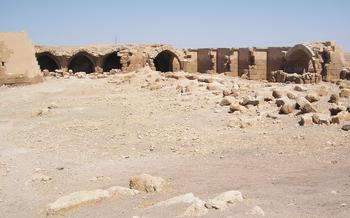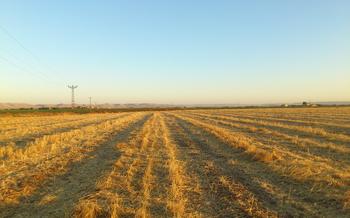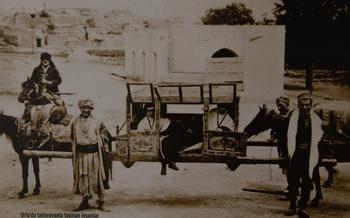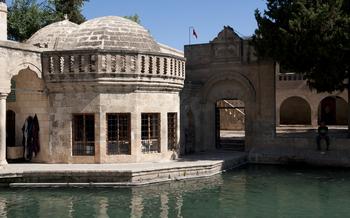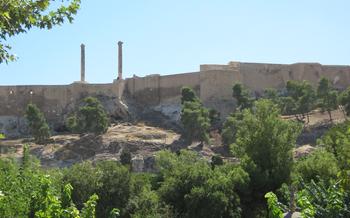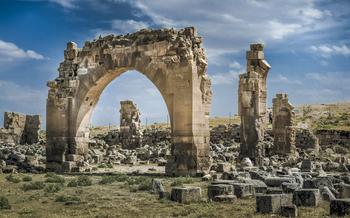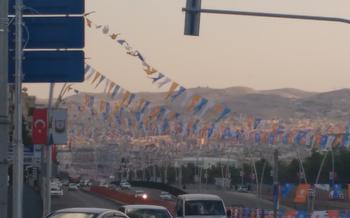
The Great Mosque of Urfa (Ulu Cami)
- The Great Mosque of Urfa (Ulu Cami)
- History and Background
- Architectural Marvel
- Religious Significance
- Cultural Heritage
- Visiting the Mosque
- Experiencing the Sacred Well
- Exploring the Courtyard
- Admire the Minarets
- Immerse in the Local Culture
- Tips for a Meaningful Visit
- Historical Context of Urfa
- Planning Your Visit
- Safety and Security
- Insider Tip: Unveiling Urfa's Hidden Treasures
The Great Mosque of Urfa (Ulu Cami)
At the heart of Şanlıurfa, nestled amidst bustling streets and vibrant markets, stands one of Turkey's most revered landmarks – The Great Mosque of Urfa, also known as Ulu Cami. This magnificent edifice, with its colossal dome and towering minarets, has witnessed centuries of history, serving as a sanctuary for worshippers, a beacon of faith, and a testament to the city's rich cultural heritage.
The mosque's origins can be traced back to the 12th century when the Zengid dynasty, known for their architectural prowess, embarked on its construction. Over time, subsequent rulers contributed to its expansion and embellishment, blending Seljuk and Ottoman architectural styles to create a unique masterpiece. Today, the Great Mosque of Urfa stands as a symbol of the city's enduring spirit, having survived numerous invasions and natural disasters, emerging as a testament to its resilience and enduring significance.
History and Background
The foundation of the Great Mosque of Urfa dates back to the Zengid dynasty's reign in the 12th century. Initially constructed as a modest prayer house, the mosque underwent significant expansion and renovations during the reign of successive rulers. In the 16th century, the Ottoman Empire's Sultan Süleyman the Magnificent ordered a comprehensive renovation, transforming the mosque into the architectural marvel it is today.
Despite its age, the mosque has remarkably survived numerous invasions and natural disasters, standing as a testament to its resilience. Throughout its history, the mosque has undergone various modifications and additions, reflecting the evolving architectural styles and cultural influences of different eras. Today, the Great Mosque of Urfa proudly stands as a symbol of the city's rich historical and cultural heritage.
Architectural Marvel
The Great Mosque of Urfa exudes architectural grandeur, blending Seljuk and Ottoman styles harmoniously. Its imposing facade captivates visitors with intricate stone carvings and decorative elements, reflecting the artistry of its builders. Step inside to marvel at the spacious prayer hall, adorned with elegant arches, columns, and mihrabs that showcase the mosque's devotion to detail. A serene courtyard awaits, offering respite from the city's bustle. In this serene space, a fountain trickles gently, surrounded by lush gardens that create a tranquil oasis. Four towering minarets rise majestically, symbolizing the power and grandeur of this architectural masterpiece.
Religious Significance
The Great Mosque of Urfa holds immense religious significance for Muslims, making it one of the most important pilgrimage sites in Turkey. It is believed to be the birthplace of Prophet Abraham, one of the most revered figures in Islamic tradition. The mosque is also home to the sacred well, known as Balıklıgöl or the Pool of Sacred Fish. This well is believed to have miraculous healing properties and is associated with numerous legends and beliefs. The presence of the sacred well has made the mosque a popular destination for both pilgrims and tourists alike.
The mosque exudes a profound sense of spirituality and devotion, making it a place of deep religious significance. Visitors can witness the fervor and faith of the worshippers as they gather for prayers, creating a truly immersive and awe-inspiring experience. The mosque serves as a testament to the rich religious heritage of Urfa and continues to be a place of worship and pilgrimage for millions of Muslims around the world.
Cultural Heritage
The Great Mosque of Urfa stands as a testament to the city's rich cultural heritage. It is an iconic landmark that embodies the essence of Islamic architectural traditions, showcasing intricate stone carvings, elegant arches, and towering minarets. The mosque has witnessed centuries of religious and cultural transformations, serving as a place of worship, pilgrimage, and learning. It is a symbol of unity, where people of different faiths come together to share in the spiritual atmosphere and appreciate the mosque's architectural grandeur. The Great Mosque of Urfa is a living heritage site that offers visitors a glimpse into the cultural and historical tapestry of this ancient city.
Visiting the Mosque
When visiting the Great Mosque of Urfa, it's essential to demonstrate respect for its religious significance. Visitors should dress appropriately, covering their shoulders and knees, and avoid wearing revealing clothing. It's important to be mindful of the daily prayer times and refrain from entering the mosque during these periods to avoid disruption.
Guided tours are available for those seeking a deeper understanding of the mosque's history and architecture. These tours provide insightful commentary and allow visitors to ask questions and learn more about the mosque's significance.
Photography is permitted in designated areas within the mosque, but visitors should be respectful of worshippers and avoid taking photographs during prayer times. It's always advisable to ask for permission before taking pictures of individuals, especially those engaged in prayer.
Experiencing the Sacred Well
Embedded within the courtyard of the Great Mosque of Urfa, lies a sacred water body known as the Pool of Sacred Fish, also revered as Balıklıgöl. This well holds profound religious significance, captivating the hearts of numerous pilgrims. Visitors are presented with the opportunity to engage in a unique ritual: feeding the sacred fish that inhabit the pool.
Legends and beliefs intertwine around the well, adding to its allure. According to local folklore, the fish in the pool are considered to be descendants of the fish that swallowed Prophet Abraham's prayers when he was thrown into a fire by King Nimrod. This miraculous event is deeply cherished by the local community, who view the fish as sacred beings.
Beyond its religious significance, the well also embodies the essence of fertility and abundance. The water is believed to possess healing properties, attracting individuals seeking blessings and rejuvenation. Visitors can immerse themselves in the cultural significance of the well, gaining insights into the beliefs and traditions of the local community.
Exploring the Courtyard
Amidst the bustling city, the courtyard of the Great Mosque of Urfa offers a sanctuary of serenity and tranquility. Step into this serene space and let the calming atmosphere wash over you. The centerpiece of the courtyard is a magnificent fountain, its intricate design and gentle flow of water creating a soothing ambiance.
Surrounding the fountain are lush gardens, a verdant oasis that invites you to stroll and soak in the beauty of nature. The fragrant flowers, vibrant greenery, and chirping birds create a symphony of sights and sounds that will soothe your senses.
Take a moment to sit on one of the benches and simply relax, letting the tranquility of the courtyard envelop you. Observe the intricate details of the mosque's architecture, from the elegant arches to the decorative motifs, all bathed in the warm glow of the sun.
The courtyard is not just a place of peace but also a place of gathering. Locals and visitors alike come here to seek solace, reflect, or simply enjoy the company of friends and family. As you sit and observe the people around you, you'll get a glimpse into the daily life of Urfa and the deep connection its residents have with this sacred space.
Admire the Minarets
The four towering minarets of the Great Mosque of Urfa stand as testaments to the grandeur and craftsmanship of Islamic architecture. These graceful structures, each adorned with intricate carvings and decorative elements, rise majestically above the cityscape, symbolizing the power and glory of the faith.
As you gaze upon these architectural wonders, take a moment to appreciate their historical significance. The minarets have stood for centuries, witnessing the evolution of Islamic architectural styles and serving as beacons of faith for generations of worshippers.
At the appointed prayer times, the melodious call to prayer echoes from the minarets, reverberating through the city and summoning the faithful to gather for their devotions. The sound, carried on the wings of the wind, creates a sense of spiritual connection and unity among the community.
Whether you are a devout Muslim or simply an admirer of architectural beauty, the minarets of the Great Mosque of Urfa are a must-see attraction. They embody the essence of Islamic culture and heritage, and their presence adds to the mosque's aura of awe and inspiration.
Immerse in the Local Culture
To truly immerse yourself in the local culture, step into the traditional tea gardens that surround the Great Mosque of Urfa. Indulge in a refreshing cup of Turkish tea, a beloved beverage deeply ingrained in the country's culture. Savor the flavors of local delicacies at nearby restaurants, where you can tantalize your taste buds with traditional dishes that reflect Urfa's culinary heritage.
Explore the vibrant markets near the mosque, where you can haggle for traditional handicrafts and souvenirs that showcase the region's skilled artisanship. Participate in cultural events and festivals that showcase local traditions, offering a glimpse into the vibrant tapestry of Urfa's cultural heritage. These events provide an opportunity to connect with the local community and gain a deeper understanding of their customs and way of life.
Tips for a Meaningful Visit
To enhance your visit to the Great Mosque of Urfa and make it a truly meaningful experience, here are some essential tips to keep in mind:
-
Respectful Behavior: Remember that the mosque is a sacred place of worship for Muslims. Be respectful of their religious beliefs and practices. Avoid loud noises, refrain from pointing your feet towards the qibla (prayer direction), and maintain a modest demeanor.
-
Silence and Contemplation: Find moments of silence and contemplation to fully appreciate the mosque's serene atmosphere. Take a break from sightseeing, sit down in a quiet corner, and let the tranquility of the surroundings wash over you.
-
Modesty in Dress: Dress modestly when visiting the mosque. Avoid revealing clothing, such as shorts, tank tops, or low-cut shirts. Women should cover their heads with a scarf or headscarf as a sign of respect.
-
Photography Etiquette: Photography is allowed in designated areas of the mosque. However, be mindful of worshippers and avoid taking pictures that might disturb their prayers. Always ask for permission before photographing individuals.
Historical Context of Urfa
Urfa, known historically as Edessa, possesses a rich tapestry of history dating back to ancient civilizations. The city's strategic location at the crossroads of major trade routes made it a melting pot of cultures and a battleground for empires. In ancient times, Edessa was ruled by various Mesopotamian and Anatolian kingdoms, each leaving their mark on the city's cultural heritage.
During the Roman period, Edessa became a significant center of Christianity and played a crucial role in the spread of the religion throughout the region. Later, the city fell under the rule of the Byzantine Empire, further enriching its cultural diversity.
In the 7th century, Urfa was conquered by the Arab armies, marking the beginning of its Islamic era. The city flourished under Islamic rule, becoming a renowned center of learning and culture. It was also during this period that the Great Mosque of Urfa was built, symbolizing the city's newfound religious significance.
Throughout history, Urfa has witnessed the rise and fall of numerous empires, including the Seljuks, Crusaders, Mongols, and Ottomans. Each empire left its own unique imprint on the city, shaping its architectural landscape and cultural traditions.
Today, Urfa stands as a testament to its rich and diverse past. Visitors can explore the city's many historical sites, including the Great Mosque, the ancient city of Harran, and the Zeugma Mosaic Museum, to gain a deeper understanding of its fascinating history.
Planning Your Visit
To make the most of your visit to the Great Mosque of Urfa, careful planning is essential. Here are some key considerations:
- Location:
The mosque is conveniently located in the heart of Urfa's old city. You can easily reach it on foot or by taking public transportation. The exact address is Ulu Cami Mahallesi, Şanlıurfa Merkez/Şanlıurfa.
- Opening Hours:
The mosque is generally open to visitors daily from morning until evening. However, it's advisable to check the specific opening hours during your intended visit, as they may vary depending on religious observances or special events.
- Tours and Guides:
For a more immersive and informative experience, consider hiring a local guide. Guided tours are available in various languages and offer in-depth insights into the mosque's history, architecture, and religious significance.
- Accommodation:
To ensure a comfortable stay, explore accommodation options near the mosque. There are numerous hotels, guesthouses, and traditional Turkish houses (han) within walking distance, catering to different budgets and preferences.
Safety and Security
When traveling to any new destination, it's crucial to prioritize your safety and security. Here are some tips to ensure a safe and enjoyable experience in Urfa:
-
Familiarize yourself with the general safety guidelines for traveling in Turkey. Stay informed about any potential risks or areas to avoid.
-
Be respectful of local customs and traditions. Dress modestly and avoid behavior that may be considered offensive or disrespectful.
-
Keep important emergency contacts handy, including the local police station and your embassy or consulate.
-
Remain vigilant and aware of your surroundings. Be cautious of pickpockets and petty theft, especially in crowded areas.
-
Avoid walking alone at night, and opt for well-lit streets and areas.
-
Trust your instincts. If a situation feels unsafe, remove yourself from it promptly.
-
Learn a few basic Turkish phrases to communicate with locals and ask for assistance if needed.
-
Consider purchasing travel insurance to protect yourself against unforeseen events such as medical emergencies or lost luggage.
Insider Tip: Unveiling Urfa's Hidden Treasures
Beyond the iconic landmarks, Urfa holds a treasure trove of lesser-known historical sites and attractions waiting to be discovered. Venture off the beaten path and explore the hidden gems that reveal the city's rich cultural heritage. Engage with locals to uncover their favorite spots and recommendations for authentic experiences. From tucked-away historical sites to vibrant markets, there's a wealth of hidden treasures to be found. Don't miss the opportunity to seek out unique souvenirs and handicrafts that represent Urfa's distinct identity. Embracing the insider's perspective will transform your journey into an unforgettable exploration of Urfa's hidden wonders.
